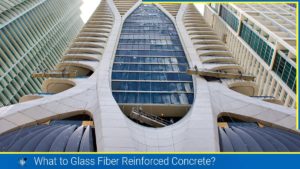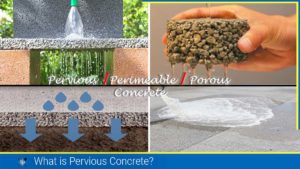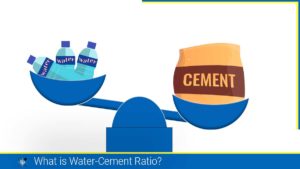Bleeding in concrete is one of the most common problems during concrete works. Bleeding in concrete is the loss of water through the surface. Excessive loss of moisture may lead to a weak concrete structure or may cause numerous problems including the appearance of concrete laitance.
What is Bleeding in Concrete?
The appearance of water on the surface of freshly laid concrete is called Bleeding. Bleeding in concrete is the appearance of a layer of water on the surface of freshly placed concrete after it has been consolidated and struck off, but before it has been set (Mindess and Young 1981). Bleeding may also be referred to as water gain, weeping, or sweating.
Concrete bleeding is a phenomenon in which the relative quantity of water in freshly mixed concrete rises to the surface and sometimes transports fine particles with it. These fine particles of cement accumulate at the top surface in the form of laitance.
Also, read: What is Cement Concrete?: Comprehensive Guide and 2 Types (PCC and RCC)
Significance of Bleeding in Concrete
Bleeding is caused by the settlement of solid particles (cement and aggregate) in the mixture and the simultaneous upward movement of water (Kosmatka, Kerkhoff, and Panarese 2002). A small amount of bleeding is normal in freshly placed concrete.
Some bleeding is helpful in controlling the development of plastic shrinkage cracking. If the rate of moisture evaporation at the surface exceeds the bleeding rate (Kosmatka 1994; Poole 2005), the surface will dry and crack. A lack of bleed water can also lead to a dry surface that can be very difficult to finish (Kosmatka 1994).
However, excessive bleeding reduces concrete strength and durability near the surface. The rising water can carry with it a considerable amount of fine cement particles, forming a layer of weak and nondurable material, called laitance, at the surface (Neville 1996).
Excessive bleeding also may delay the finishing process, which in general should not proceed until the bleed water has evaporated from the surface (Kosmatka 1994). If the surface is finished with bleed water, a thin and weak layer is created on the surface susceptible to scaling and delamination. In some cases, if the fresh concrete surface is prematurely sealed by troweling while the underlying concrete is still releasing bleed water, blisters (small hollow bumps beneath the concrete surface) can form.
Bleed water can also accumulate within the concrete mix itself, under large aggregate particles or reinforcing bars (Mindess and Young 1981). The former results in reduced concrete strength (due to decreased aggregate-paste bond). The latter may reduce the paste-steel bond, possibly promoting the corrosion of steel because the steel is not in contact with the corrosion-resistive paste (Kosmatka 1994).
Also read: Types of Cement: 10 Types and Their Usage in Construction
Causes of Concrete Bleeding
There are several causes of bleeding in concrete, but the main causes of bleeding of concrete are as follows:
- Segregation in concrete is one of the main causes in which heavier aggregate particles settle down and squeeze the water to rise upward.
- High water-to-cement ratios provide a suspension system in which heavier particles settle down easily resulting in excessive bleeding as more free water is available.
- Higher values of the Fineness modulus increase the tendency of concrete to bleed with fewer fines available.
- Low cement content has the same effect as higher values of fineness modulus as the lesser quantity of fine particles is available.
- The depth of placed concrete also affects the bleeding as deep sections of concrete bleed more than thinner sections due to the increase of pressure with an increase in depth.
Effects of Bleeding on Concrete
However, bleeding has some useful effects like reduction in water-cement ratio as well as restoration of surface moisture for control of surface shrinkage cracks. But mostly, bleeding in concrete has adverse effects on the properties and performance of concrete. Below are some listed effects of bleeding.
- Some water is trapped under aggregates and reinforcing steel and reduces the bonding among individual constituents as well as with steel reinforcements.
- The permeability of concrete increases as bleed water rises to the top by making small channels, later these channels allow the inflow of water and dissolved salts. This whole process leads to a decrease in durability.
- Delays in surface finishing due to accumulation of bleed water on the surface of pavements or floors and unsightly sand streaks due to the rise of bleed water to form surface cause poor aesthetics and surface defects in formed and finished surfaces.
- Accumulation of laitance at the surface of concrete due to bleeding reduces the bonding in horizontal joints in concrete placed in several lifts.
- Choking of concrete pump lines can happen due to excessive bleeding of concrete mixes.
How to Control Concrete Bleeding
Bleeding of concrete can be reduced considerably by employing the following control measures.
- Reducing water-cement ratio and slump of concrete, increasing cement content, and use of fine cement.
- Increasing the percentage of fine aggregates in the mix, using finer sand (FM 2.5 or less).
- Proper proportioning of concrete mix to achieve homogeneity and cohesiveness.
- Entrainment of air into the mix to increase workability and decrease in water demand.
Factors Affecting Concrete Bleeding
The initial bleeding process generally begins after agitation of the concrete mix ends and bleeding continues until the cement paste has stiffened sufficiently to resist the settlement of the solid particles (Neville 1996). The duration of bleeding depends on the thickness of the concrete section as well as the setting properties of the cementitious materials, with thinner sections or faster setting concretes exhibiting less bleeding (Kosmatka 1994).
A number of different concrete mix constituents can affect the development of bleeding.
1. Water Content and Water-Cementitious Materials (W/C) Ratio
Any increase in the amount of water or in the w/c ratio results in more water available for bleeding (Kosmatka 1994).
2. Cement
As the fineness of cement increases, the amount of bleeding decreases, possibly because finer particles hydrate earlier and also because their rate of sedimentation (settlement) is lower (Neville 1996). Increasing cement content also reduces bleeding (Kosmatka 1994). Cement with a high alkali content or a high calcium aluminate (C3A) content will exhibit less bleeding (Neville 1996).
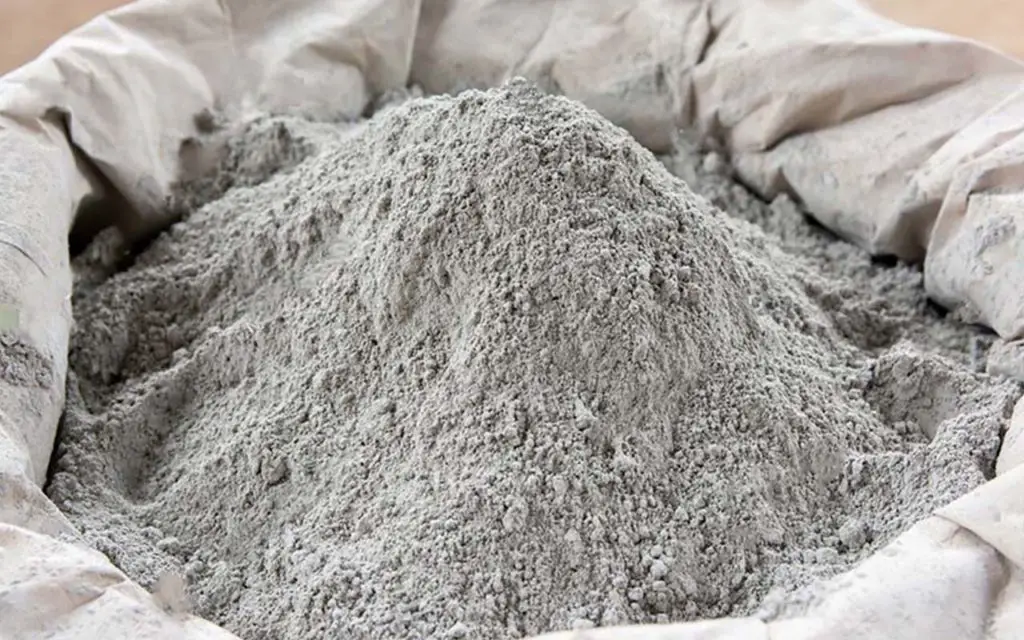
3. Supplementary Cementitious Materials
Concrete containing fly ash generally exhibits a lower bleeding rate, but due to retarded setting the total bleed volume may be similar to or greater than Portland cement concrete only. Ground, granulated blast-furnace slags have little effect on bleeding rates (Wainwright and Rey 2000). Silica fume can greatly reduce, or often stop, bleeding, largely because of the extreme fineness of the particles (Neville 1996).
4. Aggregates
Ordinary variations in aggregate grading have little effect on the bleeding of concrete mixtures, provided that there is no appreciable variation in material smaller than 75 μm. However, concrete mixtures containing aggregates with a high amount of silt, clay, or other material passing the 75-μm sieve can significantly reduce bleeding (Kosmatka 1994), although there may be other adverse effects on the concrete like increased water requirement and shrinkage.
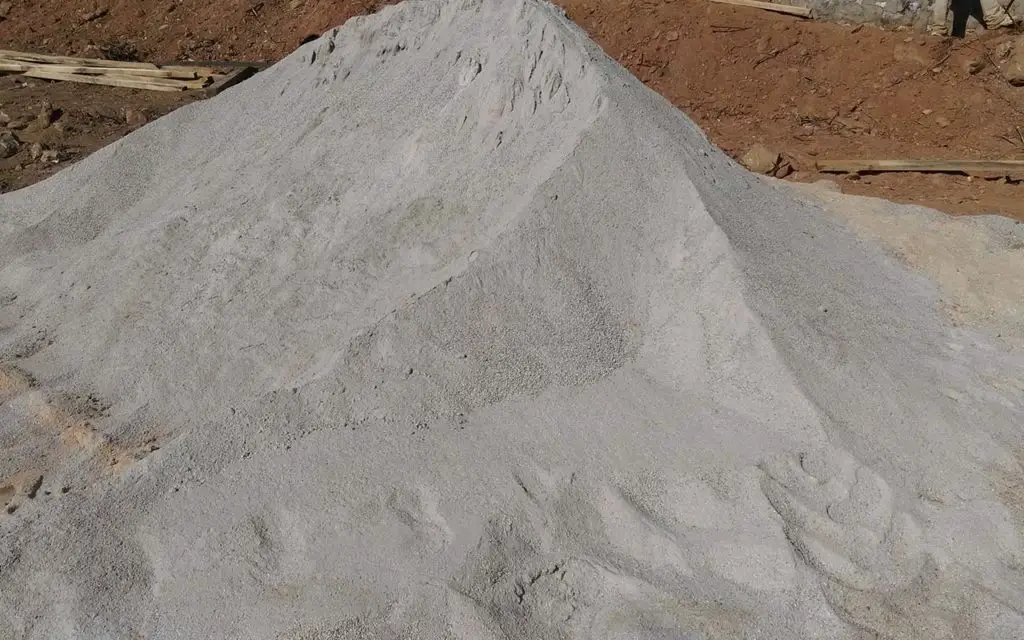
5. Chemical Admixtures
Air-entraining agents have been shown to significantly reduce bleeding in concrete, largely because the air bubbles appear to keep the solid particles in suspension (Neville 1996). Water reducers also reduce the amount of bleeding because they release trapped water in a mixture.
Summary
- Bleeding is the appearance of water at the surface of newly placed, plastic concrete due to the settlement of heavier particles.
- Some bleeding helps avoid plastic cracking in the surface, which can occur when water evaporating from the surface causes the surface to dry quickly.
- Excessive bleeding can result in voids under large aggregate particles and the formation of channels through the concrete.
- Excessive bleeding will also increase the effective water-cementitious materials ratio at the surface and weaken the surface.
- Ideally, finishing and curing should occur when bleeding has finished and the bleed water has evaporated.
- Bleeding is reduced with increasing fine content and with air-entraining and/or water-reducing admixtures.
Also Read: What is Concrete Curing?: Different Methods of Curing
FAQs:
Q: What is bleeding in concrete?
Ans: Bleeding in concrete is the appearance of a layer of water on the surface of freshly placed concrete.
Q: How to reduce bleeding in concrete?
Ans: Bleeding in concrete can be reduced by following
1. Using the right water-cement ratio.
2. Increasing cement content also reduces bleeding.
3. Using the air entraining admixtures.
4. Use fly ash or other supplementary cementitious materials.
5. By increasing the amount of fine aggregate.
Q: How long does bleeding in concrete last?
Ans: Bleeding typically occurs within the first few hours after pouring and can last for several hours or even days if the conditions are not favourable for evaporation.
Q: What causes bleeding in concrete?
Ans: Bleeding can be caused by several factors, including using too much water in the mix, overworking the concrete surface during finishing, and inadequate consolidation.
Q: Is bleeding in concrete harmful?
Ans: Bleeding itself is not harmful, but it can have negative effects on the long-term durability and strength of the concrete if it is not properly addressed.
Q: How can I prevent bleeding in concrete?
Ans: Proper mix design, avoiding overworking the surface during finishing, and adequate consolidation can all help prevent bleeding in concrete
Q: How can bleeding be distinguished from sweating in concrete?
Ans: Sweating in concrete refers to the process by which moisture from the air condenses on the surface of the concrete. It can be distinguished from bleeding by its timing and appearance. Sweating typically occurs after the concrete has set and hardened, while bleeding occurs during the initial setting period. Sweating also typically leaves a thin film of water on the surface, while bleeding can form a more substantial layer.
Q: Can bleeding be beneficial for the concrete?
Ans: Bleeding can be beneficial in certain circumstances, as it can help reduce the water-cement ratio and increase the density of the concrete. However, excessive bleeding can lead to surface defects and compromise the long-term durability of the concrete.
![]()





